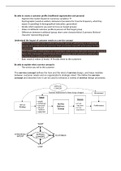UNIT ONE: WHAT IS BUSINESS?
Chapter 1 – Understanding the Nature and Purpose of Business
What is a Business?
A business is an organisation that exists to provide goods and services on a commercial
basis to customers
A good is a physical product e.g. cars, houses, phones…
A service is an intangible product e.g. hairdresser, dental services…
A start up is a new business enterprise, formed by one or more entrepreneurs
Why do businesses exist?
Businesses exist to transform inputs/resources into good/services that are in demand
(adding value)
Inputs: Outputs:
People Goods
Finance Services Transformation Process
Capital Process
Waste Products
Land & Natural Resources Businesses bring
Materials & Components benefits to the country, its economy and its
inhabitants…businesses:
Create employment and develop human capital
Create wealth by providing returns on investment
Create new products – they drive innovation through research & development
Enhance a country’s reputation
Types of Businesses
1. B2C = Businesses that supply products directly to the consumer
2. B2B = Businesses that supply products to other businesses
Business Sectors:
1. Primary
Extraction of natural resources
E.g. Mining, farming, energy extraction…
2. Secondary
Production of finished goods & components
E.g. Manufacturing, supply of energy…
3. Tertiary
Providing services
E.g. Hotels, hairdressers, retailing…
4. Quaternary
Providing information and ICT
E.g. Financial services, software development…
The Relationship between Mission and Objectives – The Hierarchy
, UNIT ONE: WHAT IS BUSINESS?
Mi
Increasingly
ssi
Strategic on
Sta
te
me
nt
Corporate
Aims
Corporate Objectives
Increasingly
Functional Objectives Detailed
Objectives set at all levels contribute to the achievement of corporate aims and missions
The hierarchy ensures that at each level the objectives are consistent with the objectives
above them
Mission Statements
A Mission Statement is a qualitative statement that sets out a business’s overall purpose
and aims that uses language to motive employees and convince those outside the firm of its
commitment
Mission Statements commonly focus on…
Reason for its existence
The organisation’s values
Non-financial goals it may peruse
The benefits of the business to the community
How consumers are to be satisfied
Visions for the future
The Value of Mission Statements:
Should make decision making easier – all actions should be directed to the mission
statement
Motivate people – they know exactly what they are trying to achieve and this can
give the business a sense of belonging and direction
Can be a powerful way of uniting people and developing corporate sprit
Differentiates the business from competitors
Drawbacks of Mission Statements:
Chapter 1 – Understanding the Nature and Purpose of Business
What is a Business?
A business is an organisation that exists to provide goods and services on a commercial
basis to customers
A good is a physical product e.g. cars, houses, phones…
A service is an intangible product e.g. hairdresser, dental services…
A start up is a new business enterprise, formed by one or more entrepreneurs
Why do businesses exist?
Businesses exist to transform inputs/resources into good/services that are in demand
(adding value)
Inputs: Outputs:
People Goods
Finance Services Transformation Process
Capital Process
Waste Products
Land & Natural Resources Businesses bring
Materials & Components benefits to the country, its economy and its
inhabitants…businesses:
Create employment and develop human capital
Create wealth by providing returns on investment
Create new products – they drive innovation through research & development
Enhance a country’s reputation
Types of Businesses
1. B2C = Businesses that supply products directly to the consumer
2. B2B = Businesses that supply products to other businesses
Business Sectors:
1. Primary
Extraction of natural resources
E.g. Mining, farming, energy extraction…
2. Secondary
Production of finished goods & components
E.g. Manufacturing, supply of energy…
3. Tertiary
Providing services
E.g. Hotels, hairdressers, retailing…
4. Quaternary
Providing information and ICT
E.g. Financial services, software development…
The Relationship between Mission and Objectives – The Hierarchy
, UNIT ONE: WHAT IS BUSINESS?
Mi
Increasingly
ssi
Strategic on
Sta
te
me
nt
Corporate
Aims
Corporate Objectives
Increasingly
Functional Objectives Detailed
Objectives set at all levels contribute to the achievement of corporate aims and missions
The hierarchy ensures that at each level the objectives are consistent with the objectives
above them
Mission Statements
A Mission Statement is a qualitative statement that sets out a business’s overall purpose
and aims that uses language to motive employees and convince those outside the firm of its
commitment
Mission Statements commonly focus on…
Reason for its existence
The organisation’s values
Non-financial goals it may peruse
The benefits of the business to the community
How consumers are to be satisfied
Visions for the future
The Value of Mission Statements:
Should make decision making easier – all actions should be directed to the mission
statement
Motivate people – they know exactly what they are trying to achieve and this can
give the business a sense of belonging and direction
Can be a powerful way of uniting people and developing corporate sprit
Differentiates the business from competitors
Drawbacks of Mission Statements:











